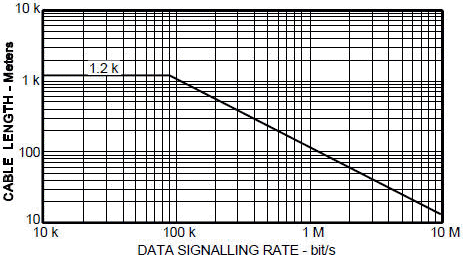Electronic Warfare and Radar Systems Engineering Handbook |
|
RS-422 BALANCED VOLTAGE INTERFACE Specifying compliance to RS-422 only establishes that the signal between the specified devices will be compatible. It does not indicate that the signal functions or operations between the two devices are compatible. The RS-422 standard only defines the characteristic requirements for the balanced line drivers and receivers. It does not specify one specific connector, signal names or operations. RS-422 interfaces are typically used when the data rate or distance criteria cannot be met with RS-232. The RS-422 standard allows for operation of up to 10 receivers from a single transmitter. The standard does not define operations of multiple tristated transmitters on a link. The RS-422-A interfaces between the Data Terminal Equipment (DTE) and Data Communication Equipment (DCE) or in any point-to-point interconnection of signals between digital equipment. It employs the electrical characteristics of balanced-voltage digital interface circuits. The balanced voltage digital interface circuit will normally be utilized on data, timing, or control circuits where the data signaling rate is up to 10 Mbit/s. While the balanced interface is intended for use at the higher data signaling rate, it may ( in preference to the unbalanced interface circuit ) generally be required if any of the following conditions prevail:
Applications of the balanced voltage digital interface circuit are shown in Figure 1.
Figure 1. Applications of a RS-422 Circuit While a restriction on maximum cable length is not specified, guidelines are given later with respect to conservative operating distances as function of data signalling rate. For a binary system in which the RS-422-A is designed, the data signalling rate in bit/s and the modulation in bauds are numerically equal when the unit interval used in each determination is the minimum interval. Electrical Characteristics: The balanced voltage digital interface circuit consists of three parts: the generator (G), the balanced interconnecting cable, and the load. The load is comprised of one or more receivers (R) and an optional cable termination resistance (RT). The balanced voltage interface circuit is shown in Figure 2. Environmental Constraints: Balanced voltage digital interface conforming to this standard will perform satisfactorily at data signalling rates up to 10 Mbit/s providing that the following operational constraints are satisfied:
Figure 2. Balanced Digital Interface Circuit Interconnecting Cable Guidelines: The maximum permissible length of cable separating the generator and the load is a function of data signalling rate and is influenced by the tolerable signal distortion, the amount of coupled noise and ground potential difference introduced between the generator and load circuit as well as by cable balance. The curve of cable length versus signalling rate is given in Figure 3. This curve is based upon using 24 AWG copper, twisted-pair cable with a capacitance of 52.5 pF/meter terminated in a 100 ohm load. As data signalling rate is reduced below 90 kbit/s, the cable length has been limited at 1200 meters by the assumed maximum allowable 6 dBV signal loss. Industry customs are not nearly as well established for RS-422 interfaces as they are for RS-232. The standard specifies use of the 37-pin "D"; the 9-pin "D" is specified for use with the secondary channel. Most data communications equipment uses the 37-pin "D"; many computer applications use a 9-pin "D" only. Some equipment applications use the 25-pin "D" defined for RS-232. Compatibility With Other Interfaces: Since the basic differential receivers of RS-423-A and RS-422-A are electrically identical, it is possible to interconnect an equipment using RS-423-A receivers and generators on one side of the interface with an equipment using RS-422-A generators and receivers on the other side of the interface, if the leads of the receivers and generators are properly configured to accommodate such an arrangement and the cable is not terminated. This circuit is not intended for interoperation with other interface electrical circuits such as RS-232-C, MIL-STD-188C, or CCITT (Comite Consultatif Internationale Telegraphique et Telephonique), recommendations V.28 and V.35. Under certain conditions, the above interfaces may be possible but may require modification of the interface or equipment; therefore satisfactory operation is not assured and additional provisions not specified herein may be required.
Figure 3. Data Signalling Rate vs Cable Length
Table of Contents for Electronics Warfare and Radar Engineering Handbook Introduction | Abbreviations | Decibel | Duty Cycle | Doppler Shift | Radar Horizon / Line of Sight | Propagation Time / Resolution | Modulation | Transforms / Wavelets | Antenna Introduction / Basics | Polarization | Radiation Patterns | Frequency / Phase Effects of Antennas | Antenna Near Field | Radiation Hazards | Power Density | One-Way Radar Equation / RF Propagation | Two-Way Radar Equation (Monostatic) | Alternate Two-Way Radar Equation | Two-Way Radar Equation (Bistatic) | Jamming to Signal (J/S) Ratio - Constant Power [Saturated] Jamming | Support Jamming | Radar Cross Section (RCS) | Emission Control (EMCON) | RF Atmospheric Absorption / Ducting | Receiver Sensitivity / Noise | Receiver Types and Characteristics | General Radar Display Types | IFF - Identification - Friend or Foe | Receiver Tests | Signal Sorting Methods and Direction Finding | Voltage Standing Wave Ratio (VSWR) / Reflection Coefficient / Return Loss / Mismatch Loss | Microwave Coaxial Connectors | Power Dividers/Combiner and Directional Couplers | Attenuators / Filters / DC Blocks | Terminations / Dummy Loads | Circulators and Diplexers | Mixers and Frequency Discriminators | Detectors | Microwave Measurements | Microwave Waveguides and Coaxial Cable | Electro-Optics | Laser Safety | Mach Number and Airspeed vs. Altitude Mach Number | EMP/ Aircraft Dimensions | Data Busses | RS-232 Interface | RS-422 Balanced Voltage Interface | RS-485 Interface | IEEE-488 Interface Bus (HP-IB/GP-IB) | MIL-STD-1553 & 1773 Data Bus | This HTML version may be printed but not reproduced on websites. |


